An effective optimization plan combines a variety of SEO best practices that comes together to help websites gain authority in SERPs. Search engine optimization isn’t one single task or strategy you implement to boost your website to the top of search engine rankings.
If you want to increase your website’s rankings, help more people find your brand through search, and grow your digital authority, you should use as many best practices for SEO as possible. Here’s a comprehensive list of the strategies you should focus on.
SEO Best Practices Checklist
Keywords
Conduct keyword research. Conduct keyword research to gain insight into the phrases your target audience searches for and to discover the keywords you’re able to rank for. To find the best keywords for your website, use Alexa’s Keyword Difficulty Tool to gain insight into search term popularity and keyword competitiveness.

Assign one primary keyword per page on your website. When you find the keywords you want to target, assign each term to one page – and only one page – on your website. Once you decide which primary keywords go with which pages, optimize those pages for the terms using on-page SEO factors described later in this post.
Don’t assign the same primary keyword to multiple pages on your website. Never assign the same target keyword to more than one page or post on your site. Using the same keyword on more than one page can lead to keyword cannibalization, which can have a negative impact on your ability to rank in search.
Never assign the same target keyword to more than one page or post on your site.
Use the primary keyword in the page title. Best practices for SEO include using the primary keyword in the page title. If possible, place the target keyword as close to the front of the title as possible.
Use the primary keyword in the page’s URL. To write an SEO friendly URL, include the primary keyword in the link structure of the page. It’s also a URL structure best practice to keep the URL fewer than 128 characters.
Use the primary keyword in the first paragraph. Help search crawlers understand the page right from the start by using the primary keyword in the first paragraph of copy on your page.
Use the primary keyword in at least one subheading. Continue to support the page’s topic by using the primary keyword in at least one subheading in the content. This tactic should be one of the easiest best practices for SEO, as the content should primarily share information related to the keyword, making this a natural task.
Use the primary keyword in the meta title. Meta titles are headlines that appear with results on a search page. Include the primary keyword in this title as it helps crawlers understand the page, but more importantly because it helps searchers find relevant results on SERPs. Keep your title to 65 characters or less so the full headline is visible in results. Also, include the primary term as close to the front of the title as possible to help catch extra attention.

Include the target keyword in the meta description. The meta description appears below the meta title in search results. It’s also important for the primary keyword to show early in this copy, so use the target term near the beginning.
Use the primary keyword in an image alt tag. When you include media on a page, show that the image is related to the topic by including the primary keyword in the image alt tag. This sends information to search crawlers about the page and also describes the image if the graphic doesn’t load.
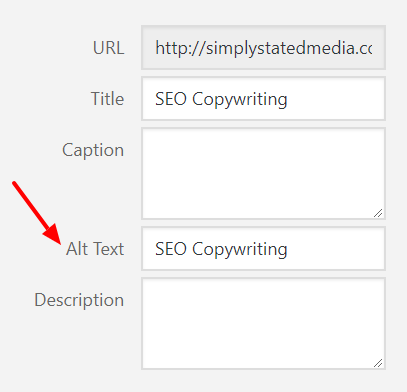
Use the primary keyword throughout the text. As you write your content, naturally use the primary keyword throughout the content. Avoid keyword stuffing by keeping your keyword density to about 2%. This is one of the most essential best practices for SEO.
Assign secondary keywords to each page on your website. Search crawlers use the content around your keywords to help understand the page. You can give them extra context about your page by using secondary keywords. Secondary keywords are terms closely related to your primary keyword.
Use the secondary keywords at least once on the page. Once you find related keywords, use each term once on the page to send extra context signals to search crawlers.
On-Site Content
Don’t publish shallow content. There is no magic word count for the exact amount of copy you should write for SEO content. But as far as best practices for SEO go, you should always aim to write at least 300 words. However, your content will be more likely to rank if it thoroughly fleshes out and explains a topic, which often can’t be done with just 300 words. So write as much as you need to cover your subject fully.
Write high-quality, high-value content. Don’t just write to reach a word count. If you want your content to rank, use these content writing tips to create high-quality evergreen content that is well-written and extremely useful and valuable. Search engines want to provide the best results, so build the top resource for your topic if you want to rank.
Regularly publish and refresh content. Send signals to search engines that your site is active and up to date by regularly publishing new content and also refreshing old pages on your site. Ensure that all of your content provides the best, most relevant information on a consistent basis to improve your search rankings.
Don’t publish duplicate page copy. One of the best practices for SEO that relates to content is not to publish copy that is the same as copy on other pages of your website. Duplicate content on your site makes it difficult for search crawlers to understand and rank your pages, which has a negative impact on your SEO.
Don’t steal content from another website. You also do not want to copy content from other websites and publish it on your site. This is a poor, unethical practice, and it can lead to search penalties. For strong on-site SEO, publish fresh, original content.
Use canonical tags on duplicate content. If you need to publish content that is already published on another webpage (whether it is on your site or another website), use a canonical tag that tells search bots to ignore the duplicate content. This tag points the crawler to the original copy. It doesn’t add SEO value to your site, but it helps you avoid duplicate content penalties.
Don’t publish duplicate meta title tags and descriptions. Just as you don’t want to publish the same copy on pages, you don’t want to publish duplicate SEO meta descriptions. Write unique meta titles and descriptions for each page on your site. Also, keep the description to under 320 characters and don’t use special characters to ensure that your entire description will show up properly on SERPs.
Include images and graphics on your pages. Search crawlers look for the best information to return as top results. They often consider content that supports copy with graphics as a better resource, and therefore, give it higher rankings. So include rich media, like images, graphics, and videos on your pages.
Use brief, descriptive image file names. When you add images to your pages, pay attention to the name of the file. Use brief file names that describe the image, and also include the primary keyword in the file name. Like the image alt tag, this is one of the best practices for SEO, as it sends bonus signals to search engines.
Links
Include links on each page of your website. Online audiences use links to navigate around a website. Include links on each of your pages, so users aren’t met with a dead end that requires them to use the back button or leave your site.
But don’t include too many links. On the flip side, too many links can be confusing to users and make your site difficult to navigate and crawl. So best practices for SEO include keeping the number of pages with more than 100 links to a minimum and avoiding pages with more than 1,000 links.
Link to other internal pages on your website. Links on your website should lead to other pages on your site to help users navigate and find information. Internal links also send signals to search engines and help them crawl and understand your pages.
When adding internal links, use the page’s target keyword as the anchor text. To make internal links on your site more useful to search crawlers, link using the page’s target keyword as the anchor text.
Link to other high-quality websites. Don’t just link to your internal pages on your site. Also, show search engines that your site is connected to the larger digital world. When relevant, link to sources and resources that add value and context to your pages.
PRO TIP: Always set outbound links to open in a new window to keep users on your page.
Fix broken links on your site. Links that don’t work, are broken, or generate an error instead of going to the expected page, file, or image have a negative impact on SEO. Ensure that all of the inbound and outbound links on your site work.
Avoid having too many redirects. Clean up links on your site to improve SEO by avoiding redirecting too many of your site’s pages to other pages. Replace redirects with direct links. If you need to redirect some of your pages, configure your server to return a “301” or permanent redirect instead of a “302” temporary redirect.
Attract backlinks from high-authority websites. Links pointing to your site are just as important, if not more important, than the links on your site. A major ranking factor is how many high-quality sites link back to yours. Best practices for SEO must include a strong strategy for attracting high-quality backlinks to your site.
Remove links from low-authority websites. Backlinks leading to your site can have a negative impact if they are coming from a spammy, low-quality site. So use Alexa’s Site Linking In Tool to review a list of the sites linking to your site. Attempt to remove links from low-quality sites by reaching out to ask them to take down the link or by using the Google Disavow Tool. (Google doesn’t like you to overuse this tool, so only use it when necessary.)
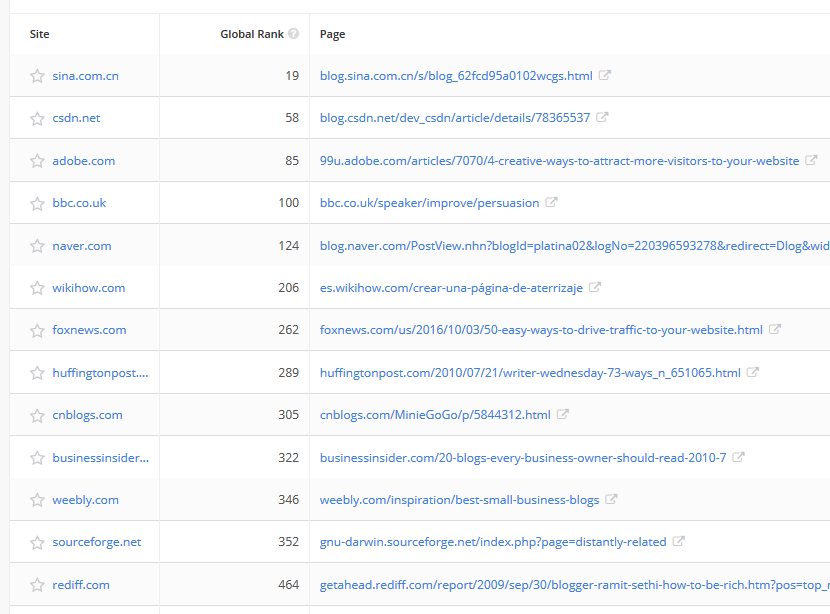
Local SEO
Set up a Google business page. Best practices for SEO as they relate to local searches include creating a Google My Business page. This practice is especially important for brick-and-mortar businesses as it shows a rich result on local Google SERPs.
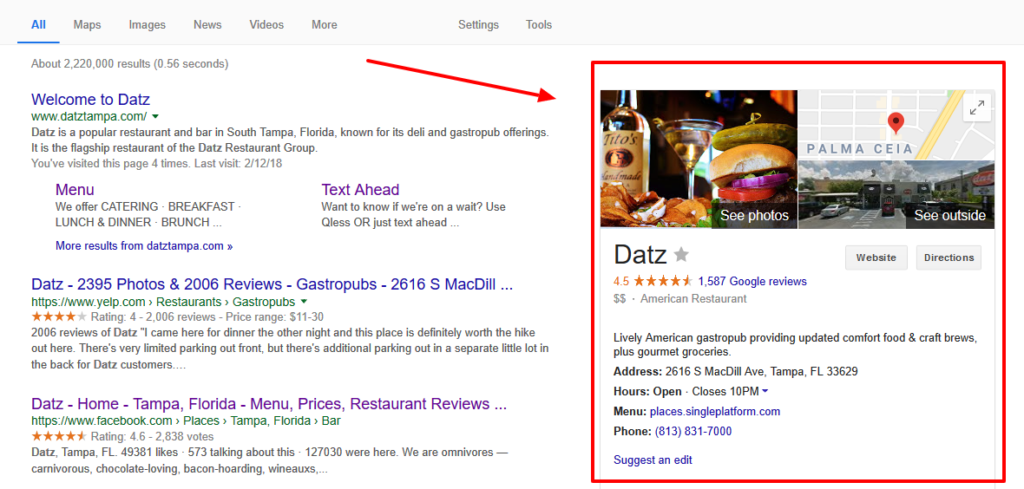
Add your website to relevant business directories. Work to build your online presence by creating profiles for your business on relevant digital directories. Choose general business directories (like Yelp, Yellow Pages, Angie’s List, etc.) as well as listing sites that are relevant to your industry. Always include a link back to your website in your profile.
Link to your website on all social media profiles. Create social profiles for your business that also include a link back to your website. These links help build a strong backlink portfolio while driving traffic to your site.
Make sure all of your NAP entries are consistent. NAP stands for name, address, and phone. NAPs for businesses are often included in business directories. Make sure all of your business’ NAP references are accurate as one of the best practices for SEO as it relates to local search.
Include your address in the footer of your website. Help search engines connect your business with a specific geographic region to improve your local search rankings. Include the physical location of your business (or multiple locations of your business) in the footer of your website.
Technical SEO
Add an SSL certificate to your site An SSL certificate adds a layer of security to your site. It changes your site URL from “http” to “https.” If your site doesn’t have an SSL certificate, search browsers will alert users that your site could be unsafe, and it can have a negative impact on your search rankings.
Increase the speed of your website. The load speed of your website affects the user experience, conversion rates, and the number of pages that search engines index. Use tactics to optimize your site for speed and user experience.
A two-second delay in web page load time increase bounce rates by 103 percent. (Source: Akamai)
Use a responsive, mobile-friendly design. Mobile-responsive websites adapt to fit the screen size of the user. It’s one of the best practices for SEO and also user experience to use this type of design.
Consider using AMP pages. To make your site even more mobile-friendly, use AMP pages that make blog posts easier to read and quicker to load on handheld devices.
Create a Google Webmasters account and submit your sitemap. Give Google a good look at your site by setting up a Google Webmaster account and submitting a map of your site.
Create a Bing Webmasters account and submit your sitemap. Bing is also a popular search tool for users, so also set up a Bing Webmaster account and submit a sitemap to their directory.
Properly use robots.txt. A robots.txt file tells search engines whether they can access and crawl parts of your site. There are situations where you want to use this file. You may want to hide unimportant or sensitive pages on your site. But you also need to ensure that this file isn’t blocking pages on your site that you want crawlers to access.
Add structured data markup. Structured data are code you can add to your sites to better explain your content to search engines. Use this data to send better signals to search engines and improve the appearance of your search results – as structured data or schemas can add additional information to search engine results.

Point all domains to the same host. Many sites allow users to visit them through different hostnames (e.g., both http://domain.com and http://www.domain.com). It is one of the best practices for SEO to make sure that both of these points to the other.
Utilize organized and natural site architecture. Sites with good page hierarchy and structure are more visible in search engine results because the search engine crawler can find more pages. Set up your site so that it is well-structured and well-linked.
Track analytics and monitor website activity. The only way to continue to improve your SEO is to track and monitor the activity on your site. Install Google Analytics to view trends and user habits to learn how to improve your site layout and optimization.
Readability
Use natural language in your copy. Along with technical factors and keyword optimization, the structure and quality of your copy is still a major ranking factor. Readability impacts a page’s ability to show up in search, especially voice search. So use natural, well-written language to provide a better experience for readers and to improve semantic SEO.
Write for an eighth-grade reading level. Writing well doesn’t mean writing for a high-reading level. The best SEO-friendly copy is written for an eighth-grade reading level because it is easy to absorb and understand.
Make content easy to read and scan. Another way to make copy easy to understand is by formatting the content so it’s clear and scannable. Use short paragraphs, include bullets, and use bolded font intuitively to make your copy easy for both readers and search crawlers to review and understand.
See If You’re Following the Best Practices for SEO
Even with this SEO best practices checklist, it’s still easy to miss important steps that can be influential in boosting your SEO.
Make sure you never miss an opportunity to improve your SEO by using Alexa’s SEO Audit Tool. The tool runs a report on the entire SEO status of your site, pointing out errors and providing directions for improving elements that will boost your search visibility.
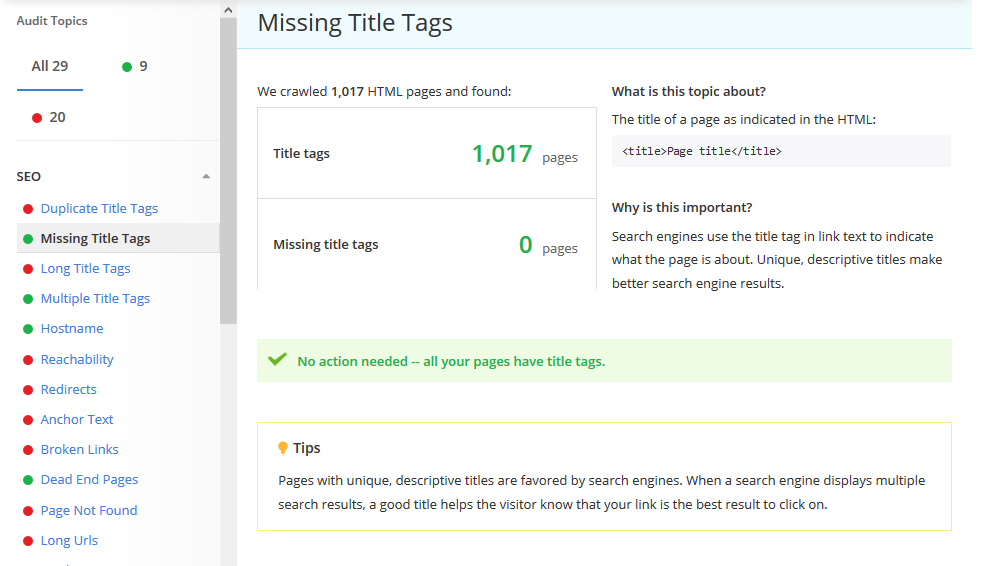
Then, make sure each page on your site is properly optimized for its target keyword. Use Alexa’s On-Page SEO Checker to audit each page on your site. Enter the site URL and target keyword to get a report on how to improve the page to match best practices for SEO.
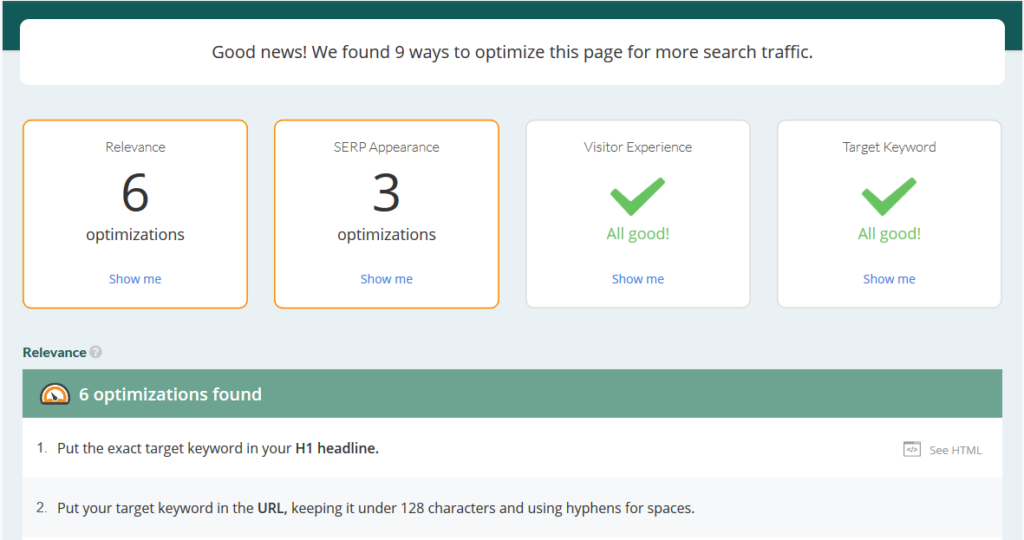
With so many steps, trying to remember all of the best practices for SEO can be challenging. But executing each strategy is easy when you have Alexa tools that point out where you are missing optimization opportunities or making mistakes. Try the tools today. Sign up for a free 7-day trial of Alexa’s Advanced Plan to get all of the tools mentioned in this post, along with other useful keyword research and SEO reports and tools.
Source: Alexa | blog




